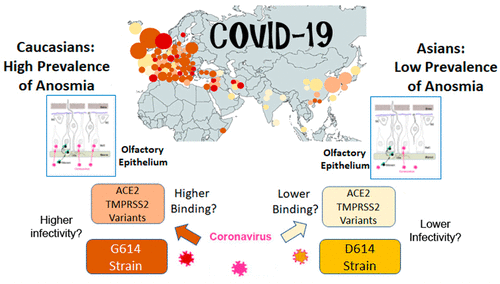当前位置:
X-MOL 学术
›
ACS Chem. Neurosci.
›
论文详情
Our official English website, www.x-mol.net, welcomes your
feedback! (Note: you will need to create a separate account there.)
Prevalence of Chemosensory Dysfunction in COVID-19 Patients: A Systematic Review and Meta-analysis Reveals Significant Ethnic Differences.
ACS Chemical Neuroscience ( IF 4.1 ) Pub Date : 2020-09-01 , DOI: 10.1021/acschemneuro.0c00460 Christopher S von Bartheld 1 , Molly M Hagen 2 , Rafal Butowt 3
ACS Chemical Neuroscience ( IF 4.1 ) Pub Date : 2020-09-01 , DOI: 10.1021/acschemneuro.0c00460 Christopher S von Bartheld 1 , Molly M Hagen 2 , Rafal Butowt 3
Affiliation

|
A significant proportion of people who test positive for COVID-19 have chemosensory deficits. However, the reported prevalence of these deficits in smell and taste varies widely, and the reason for the differences between studies is unclear. We determined the pooled prevalence of such chemosensory deficits in a systematic review and meta-analysis. We searched the COVID-19 portfolio of the National Institutes of Health for studies that reported the prevalence of smell or taste deficits or both in patients diagnosed with COVID-19. One-hundred-four studies reporting on 38 198 patients qualified and were subjected to a systematic review and meta-analysis. Estimated random prevalence of olfactory dysfunction was 43.0%, that of taste dysfunction was 44.6%, and that of overall chemosensory dysfunction was 47.4%. We examined the effects of age, gender, disease severity, and ethnicity on chemosensory dysfunction. Prevalence of smell or taste dysfunction or both decreased with older age, male gender, and disease severity. Ethnicity was highly significant: Caucasians had a three times higher prevalence of chemosensory dysfunctions (54.8%) than Asians (17.7%). The finding of geographic differences points to two causes that are not mutually exclusive. A virus mutation (D614G) may cause differing infectivity, while at the host level genetic, ethnicity-specific variants of the virus-binding entry proteins may facilitate virus entry in the olfactory epithelium and taste buds. Both explanations have major implications for infectivity, diagnosis, and management of the COVID-19 pandemic.
中文翻译:

COVID-19 患者化学感应功能障碍的患病率:系统回顾和荟萃分析揭示了显着的种族差异。
很大一部分 COVID-19 检测呈阳性的人存在化学感应缺陷。然而,所报告的嗅觉和味觉缺陷的患病率差异很大,并且研究之间存在差异的原因尚不清楚。我们通过系统评价和荟萃分析确定了此类化学感应缺陷的汇总患病率。我们检索了美国国立卫生研究院 (National Institutes of Health) 的 COVID-19 组合,查找报告了诊断为 COVID-19 的患者中嗅觉或味觉缺陷或两者兼有的患病率的研究。报告了 38 198 名患者的 104 项研究合格,并接受了系统评价和荟萃分析。嗅觉功能障碍的随机患病率为 43.0%,味觉功能障碍的随机患病率为 44.6%,总体化学感觉功能障碍的随机患病率为 47.4%。我们研究了年龄、性别、疾病严重程度和种族对化学感应功能障碍的影响。嗅觉或味觉功能障碍或两者兼而有之的患病率随着年龄的增长、男性性别和疾病的严重程度而降低。种族差异非常显着:白种人的化学感应功能障碍患病率 (54.8%) 是亚洲人 (17.7%) 的三倍。地理差异的发现指出了两个并不相互排斥的原因。病毒突变(D614G)可能会导致不同的感染性,而在宿主水平上,病毒结合进入蛋白的遗传、种族特异性变体可能会促进病毒进入嗅觉上皮和味蕾。这两种解释对 COVID-19 大流行的传染性、诊断和管理都有重大影响。
更新日期:2020-10-07
中文翻译:

COVID-19 患者化学感应功能障碍的患病率:系统回顾和荟萃分析揭示了显着的种族差异。
很大一部分 COVID-19 检测呈阳性的人存在化学感应缺陷。然而,所报告的嗅觉和味觉缺陷的患病率差异很大,并且研究之间存在差异的原因尚不清楚。我们通过系统评价和荟萃分析确定了此类化学感应缺陷的汇总患病率。我们检索了美国国立卫生研究院 (National Institutes of Health) 的 COVID-19 组合,查找报告了诊断为 COVID-19 的患者中嗅觉或味觉缺陷或两者兼有的患病率的研究。报告了 38 198 名患者的 104 项研究合格,并接受了系统评价和荟萃分析。嗅觉功能障碍的随机患病率为 43.0%,味觉功能障碍的随机患病率为 44.6%,总体化学感觉功能障碍的随机患病率为 47.4%。我们研究了年龄、性别、疾病严重程度和种族对化学感应功能障碍的影响。嗅觉或味觉功能障碍或两者兼而有之的患病率随着年龄的增长、男性性别和疾病的严重程度而降低。种族差异非常显着:白种人的化学感应功能障碍患病率 (54.8%) 是亚洲人 (17.7%) 的三倍。地理差异的发现指出了两个并不相互排斥的原因。病毒突变(D614G)可能会导致不同的感染性,而在宿主水平上,病毒结合进入蛋白的遗传、种族特异性变体可能会促进病毒进入嗅觉上皮和味蕾。这两种解释对 COVID-19 大流行的传染性、诊断和管理都有重大影响。











































 京公网安备 11010802027423号
京公网安备 11010802027423号